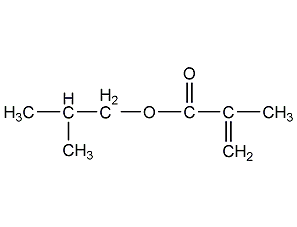
Structural formula
| Business number | 02CT |
|---|---|
| Molecular formula | C8H14O2 |
| Molecular weight | 142.20 |
| label |
2-Methylpropyl-2-methyl-2-acrylate, Methyl isobutyl ester, IBMA, Methacrylic acid isobutyl ester, aliphatic compounds, functional materials |
Numbering system
CAS number:97-86-9
MDL number:MFCD00008931
EINECS number:202-613-0
RTECS number:OZ4900000
BRN number:1747595
PubChem number:24883154
Physical property data
1. Properties: colorless and transparent liquid[1]
2. Melting point (℃): -60.9[2]
3. Boiling point (℃): 155[3]
4. Relative density (water=1): 0.89[4]
5. Relative vapor density (air=1): 4.91[5]
6. Saturated vapor pressure (kPa): 0.48 (25℃) [6]
7. Critical pressure (MPa): 2.67[7]
8. Octanol/water distribution Coefficient: 2.66[8]
9. Flash point (℃): 44; 49 (OC)[9]
10. Ignition temperature (℃): 294[10]
11. Explosion upper limit (%): 8[11]
12. Lower explosion limit (%): 2.0[12]
13. Solubility: insoluble in water, easily soluble in ethanol and ether. [13]
Toxicological data
1. Acute toxicity: Rat inhalation LCLo: 200 mg/m3/4H; mouse oral LD50: 11990mg/kg; mouse inhalation LCLo: 29740 mg/m3/5H; mouse peritoneal cavity LD50: 1340mg/kg; dog Intravenous injection of LDLo: 134μL/kg; 2. Reproductive toxicity: TDLo in the peritoneal cavity of rats 5-15 days after conception: 1401mg/kgSEX/DURATION; TDLo in the peritoneal cavity of rats 5-15 days after conception: 420mg/kgSEX/DURATION; 3 , irritating to eyes, respiratory system and skin. Contact with skin can cause allergies. Extremely toxic to aquatic life.
4. Acute toxicity[14] LD50: 6400~12800mg/kg (rat oral); 11990mg/kg (small Rat orally)
Ecological data
1. Ecotoxicity No data yet
2. Biodegradability[15] MITI-I test, initial concentration 100ppm, sludge concentration 30ppm, degradation 33% in 28 days.
3. Non-biodegradability[16] In the air, when the hydroxyl radical concentration is 5.00×105 pieces/cm3, the degradation half-life is 17h (theoretical).
4. Bioconcentration[17] BCF: 62 (theory)
5. Other harmful effects[18] This substance may be harmful to the environment, and special attention should be paid to water bodies. .
Molecular structure data
1. MountEr refractive index: 40.41
2. Molar volume (cm3/mol): 159.3
3. Isotonic specific volume (90.2K): 357.7
4. Surface tension (dyne/cm): 25.4
5. Polarizability: 16.02
Compute chemical data
1. Reference value for hydrophobic parameter calculation (XlogP): None
2. Number of hydrogen bond donors: 0
3. Number of hydrogen bond acceptors: 2
4. Number of rotatable chemical bonds: 4
5. Number of tautomers: none
6. Topological molecule polar surface area 26.3
7. Number of heavy atoms: 10
8. Surface charge: 0
9. Complexity: 136
10. Number of isotope atoms: 0
11. Determine the number of atomic stereocenters: 0
12. Uncertain number of atomic stereocenters: 0
13. Determine the number of chemical bond stereocenters: 0
14. Number of uncertain chemical bond stereocenters: 0
15. Number of covalent bond units: 1
Properties and stability
1. The toxicity of isobutyl methacrylate is basically the same as that of methyl methacrylate, and the protection requirements are also the same. See methyl methacrylate.
2. Stability[19] Stable
3. Incompatible substances[20] Strong oxidants, strong acids, strong alkali
4. Conditions to avoid contact [21] Heat, light, ultraviolet rays , contact with air
5. Polymerization hazard[22] Polymerization
Storage method
Storage Precautions[23] Usually products contain polymerization inhibitors. Store in a cool, ventilated warehouse. The storage temperature should not exceed 37°C. Keep away from fire and heat sources. The packaging must be sealed and must not come into contact with air. They should be stored separately from oxidants, acids, and alkalis, and avoid mixed storage. It should not be stored in large quantities or for long periods of time. Use explosion-proof lighting and ventilation facilities. It is prohibited to use mechanical equipment and tools that are prone to sparks. The storage area should be equipped with emergency release equipment and suitable containment materials.
Synthesis method
Methacrylic acid and isobutanol are esterified under the catalysis of sulfuric acid, and then distilled to obtain the finished product. Methacrylic acid is produced from acetone cyanohydrin.
![]()
Purpose
1. Isobutyl methacrylate is an organic synthetic monomer used in synthetic resins, plastics, coatings, printing inks, adhesives, lubricant additives, dental materials, fiber treatment agents, paper finishing agents, etc.
2. As a monomer in organic synthesis, it is used in synthetic resins, plastics and coatings. [24]

 微信扫一扫打赏
微信扫一扫打赏

